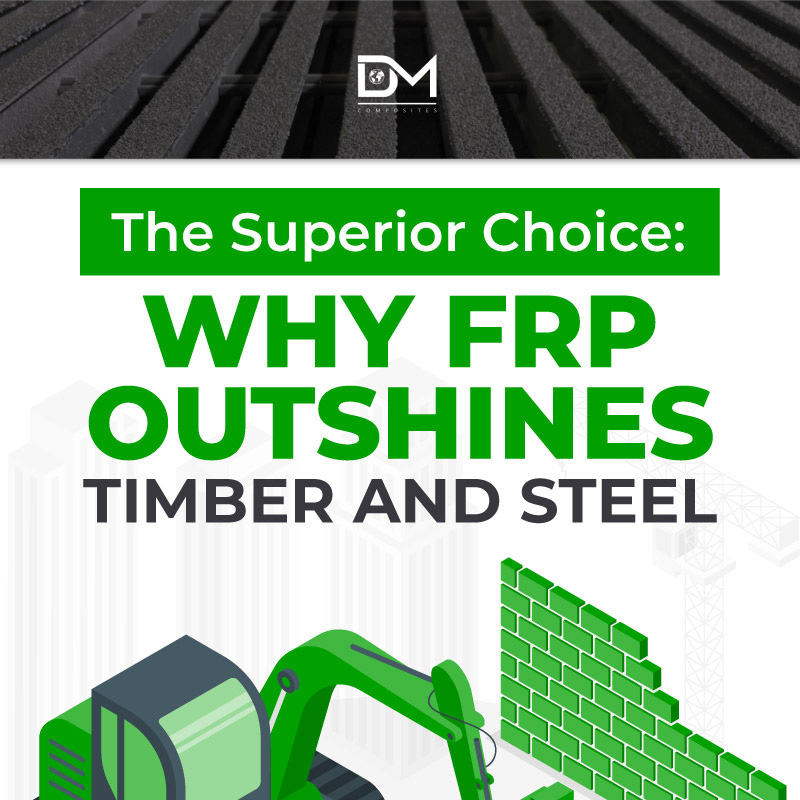Fibre-reinforced Polymer (FRP) materials have revolutionised the construction industry in recent years, providing superior benefits to traditional materials like steel and wood. Their greater strength-to-weight ratio, durability, and cost-effectiveness made them an ideal alternative to projects where safety and sustainability are paramount.
However, the benefits of adopting FRP composites continue beyond steel and wood. FRP also boasts several advantages over other popular material choices like aluminium and concrete, providing long-term benefits at a fraction of the price.
The two materials have been used in countless applications across many industries, but FRP provides features that can outshine aluminium and concrete on any given day.

Read More: The Superior Choice: Why FRP Outshines Timber and Steel
FRP vs. Aluminum
Aluminium is widely used in the modern world. Its lightweight nature, corrosion-resistance properties, and sophisticated look make it an ideal choice for the external façade and walls of metal buildings. However, its low strength makes it highly vulnerable to impact, which can result in significant deformation.
Switching to FRP gratings can do wonders in multiple ways as it provides better performance and safety features compared to aluminium, including:
· Higher Tensile Strength
FRP is known for its lightweight properties, weighing significantly less than aluminium and other materials. Despite this, FRP has a higher tensile strength than aluminium, with most FRP made with fibreglass having 483-4580 MPa of tensile strength, making it ideal for projects that require lightness and durability.
· Superior Strength-to-Weight Ratio
While aluminium can be strong depending on the application, it requires more mass to achieve the strength of other materials. FRP composites are renowned for their superior strength-to-weight ratio, making them ideal choices for applications in high-stress and weight-sensitive environments where maintaining structural integrity with minimal material is vital.
The superior strength-to-weight ratio allows for optimal performance in projects where contractors need to reduce weight, such as large-scale industrial structures.
· Better Corrosion Resistance
While aluminium doesn’t rust, it is highly prone to oxidation and corrosion in the long run, especially if exposed to other metals or extreme pH levels. To minimise corrosion, aluminium requires constant treatment through coatings and anodising processes, but this does not guarantee that it will maintain its quality for a long time.
This is where FRP stands tall compared to aluminium: It is inherently resistant to corrosion caused by water, chemicals, or even UV radiation. Its non-metallic nature means it does not corrode in the same way as aluminium, ensuring a longer lifespan and reduced maintenance work even if exposed to extreme conditions.
· Cost Efficiency
Aluminium might have a lower upfront cost, but its vulnerability to damage can result in the need for regular inspections, coatings, or replacements, which can pile up and strain the budget.
The extended lifecycle and minimal upkeep work needed for FRP allow developers and enterprises to save money on operating costs over time. FRP composites can maintain their structural integrity for a long time, reducing the need for repair or replacements, which can also reduce total lifecycle costs.
FRP vs Concrete
The importance of concrete in the modern world cannot be overstated. Almost anywhere you look, you will likely see a structure made using concrete. Their exceptional strength makes them a top pick for many projects because of their sturdiness and longevity. However, it still has its flaws, which have made FRP a better choice for many projects over time.
· Lightweight
It is no secret that concrete is probably the heaviest material, requiring large and specialised machinery to transport and install it, especially in large-scale developments. It is also impossible to transport concrete in one go, adding to the total cost of the project.
Meanwhile, FRP only weighs around eight times less than reinforced concrete. This translates to much easier handling and installation, especially for projects in remote areas where access can be limited. The lightweight nature of FRP also allows for reduced trips to transport the material from the yard to the development site, lowering fuel consumption and overall costs.
Despite being lightweight, FRP composites can also match or even exceed the strength that concrete provides. This makes FRP ideal for applications where weight is a critical factor, including bridges and elevated infrastructure. Using FRP for these infrastructures can also ensure user safety, even if it only uses a much lighter framework.
· Flexibility and Customisation
Yes, concrete is one of the strongest materials around, but its rigidity significantly limits its application in various environments. Once they cool down, concrete usually comes in predetermined shapes with little to no room for adjustment or flexibility. This can be a drawback in certain applications where movement and dynamic loads are present since concrete usually cracks under these conditions.
FRP composites are highly flexible in terms of design and customisation and can be moulded into various shapes and configurations in the manufacturing process. This gives engineers more freedom to create more complex and unique designs that might be difficult to achieve with concrete, such as marine boardwalks or customised architectural solutions.
· Resistance to Degradation
Despite its strength, concrete is vulnerable to several environmental factors, including moisture and chemicals, that can cause flaws in its structural integrity. This will cause the concrete structure to crack and erode over time, risking the safety of people using the infrastructure.
FRP is highly resistant to these factors as it does not absorb moisture or corrode when in contact with chemicals. They make the perfect material for harsh or corrosive environments, including marine and industrial settings, offering long-term durability and optimal performance.
· Sustainability
Adopting sustainable practices has been a priority for many industries in recent years, and FRP supports this by emitting significantly less carbon during production. Cement production accounts for 8% of total CO2 emissions, and the constant transport requires substantial fuel consumption that adds to the carbon footprint.
Meanwhile, producing FRP requires much less energy, especially considering its lifespan and reduced maintenance needs. It is also more efficient to transport, making it the more environmentally friendly option for initial production and long-term sustainability goals.
Conclusion
The increasing need to adopt sustainable materials that can provide the same level of performance and safety as traditional materials has led to the growth of FRP in recent decades. Apart from timber and steel, FRP also provides clear advantages over concrete and aluminium that will revolutionise construction for years to come.
If you are interested in adopting composite solutions for your projects and are looking for the best Australian supplier, DM Composites is for you. We have been the standout choice for many Australian public and private organisations, consistently delivering quality and sustainable solutions to our partners.
Visit www.dmcomposites.com.au/contact-us if you have inquiries about our products and services.
Beyond Traditional Materials: Exploring the Advantages of DM Composites Solutions


